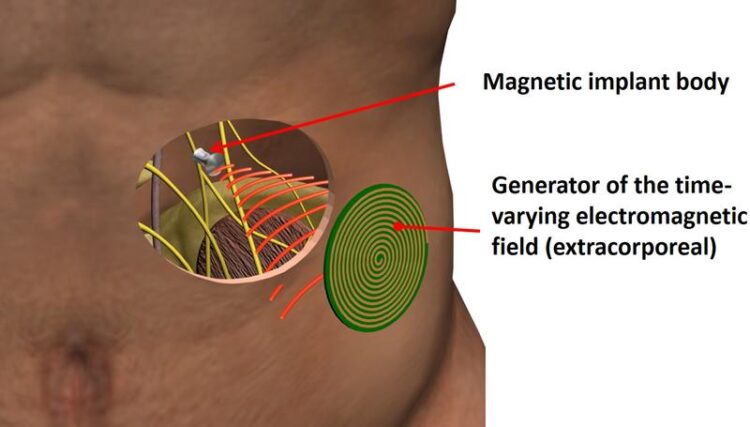Electrostimulation instead of medication: Magnetoceuticals

Principle sketch of the "Magnetoceuticals" approach: Only a magnetic implant body is implanted into the human body. The entire intelligence of the electronic system is located in the extracorporeal, miniaturized electronics.
Fraunhofer IBMT
Approach to electromagnetic stimulation of nervous tissue
Today, a large number of diseases are treated with medication. This is often associated with side effects that can be serious for people who are already ill. A new therapeutic approach, known under the keyword “bioelectronic medicine”, provides for the therapy of diseases by means of electrostimulation. Since April 2019, the Fraunhofer Institute for Biomedical Engineering IBMT has been contributing its many years of expertise in the field of intelligent miniaturized active implants to the BMBF joint project “Magnetoceuticals” to develop a novel electrostimulation system for nerve tissue.
In the BMBF joint project “Magnetoceuticals”, a consortium is developing a novel variant of this approach, using magnetic fields to stimulate nerve tissue. The main components of the system are an electronic device worn externally on the body and a purely passive, highly miniaturized implant. The implant is a biocompatible encapsulated magnetic body and comprises neither electronics nor electrode contacts.
The electronics worn on the body emit time-varying magnetic fields in the direction of the implant. The implant concentrates these fields and transmits them to the stimulation site. According to Maxwell’s equations, the time-varying magnetic field results in a time-varying electric field, which – if all parameters are appropriately selected – triggers an action potential in the tissue to be stimulated. The stimulation should be as effective and spatially resolved as is already the case today with very complex implants. This type of therapy does not require medication or implanted electronics and electrodes.
Innovation promises gentle patient treatment
The innovation in the “Magnetoceuticals” project consists in selective stimulation of nerves without electrodes and implanted electronics. This eliminates cable connections between implant electronics and electrodes and problems such as cable breakage or electrode corrosion are avoided. Since the implant has no electronics, no special precautions need to be taken to protect the implant from moisture and, due to the absence of an implant battery, the implant life is practically unlimited.
This completely eliminates the need for surgical procedures for battery replacement. In addition, the implant is easy to implant and explant due to its small and simple design and is thus gentle on the patient. The locally focused stimulation, which does not require an implant battery, is particularly suitable for applications where temporary stimulation is desired to relieve symptoms, such as pain management, lowering high blood pressure, combating migraines or reducing obesity.
Fraunhofer IBMT expertise in use
The main focus of the Fraunhofer IBMT’s work is on the simulation of the overall system, the development of the implant bodies and the testing of the assembled systems. One challenge is to find a combination of the temporal course of the external magnetic field and the geometry as well as the material of the implant body, which, despite the existing limitations of existing magnetic materials in terms of permeability and saturation magnetization, lead to electric fields at the tissue to be stimulated, which trigger action potentials.
Computer simulations were used to find a suitable system configuration and to optimize the geometry of the implant body. The next step is to develop an electronic system that guarantees the necessary time behaviour of the magnetic fields. Finally, the system will be tested on nerve tissue.
In addition to the already mentioned advantages of the electrodeless stimulation system, the simulations interestingly revealed a further advantage in terms of user safety: The geometry of the implant body can be designed in such a way that the implant body enters magnetic saturation as soon as it is exposed to magnetic fields exceeding the strength required for stimulation. Overstimulation by extremely strong magnetic fields can thus be ruled out by the clever design of the implant body alone.
Project funding: BMBF 16ES0956 (KMU-innovativ: Electronics and autonomous driving)
Project duration: 04/2019 – 03/2022
Network coordinator:
OSYPKA AG, Rheinfelden (Baden), Germany
Project partners (Germany):
CORSCIENCE GmbH & Co. KG, Erlangen
Fraunhofer Institute for Biomedical Engineering IBMT, Sulzbach
Wissenschaftliche Ansprechpartner:
Contact at the Fraunhofer IBMT:
Dr. Thomas Velten
Head of Department Biomedical Microsystems
Phone: +49 6897 9071 450
E-mail: thomas.velten@ibmt.fraunhofer.de
Weitere Informationen:
Media Contact
All latest news from the category: Medical Engineering
The development of medical equipment, products and technical procedures is characterized by high research and development costs in a variety of fields related to the study of human medicine.
innovations-report provides informative and stimulating reports and articles on topics ranging from imaging processes, cell and tissue techniques, optical techniques, implants, orthopedic aids, clinical and medical office equipment, dialysis systems and x-ray/radiation monitoring devices to endoscopy, ultrasound, surgical techniques, and dental materials.
Newest articles

Parallel Paths: Understanding Malaria Resistance in Chimpanzees and Humans
The closest relatives of humans adapt genetically to habitats and infections Survival of the Fittest: Genetic Adaptations Uncovered in Chimpanzees Görlitz, 10.01.2025. Chimpanzees have genetic adaptations that help them survive…

You are What You Eat—Stanford Study Links Fiber to Anti-Cancer Gene Modulation
The Fiber Gap: A Growing Concern in American Diets Fiber is well known to be an important part of a healthy diet, yet less than 10% of Americans eat the minimum recommended…

Trust Your Gut—RNA-Protein Discovery for Better Immunity
HIRI researchers uncover control mechanisms of polysaccharide utilization in Bacteroides thetaiotaomicron. Researchers at the Helmholtz Institute for RNA-based Infection Research (HIRI) and the Julius-Maximilians-Universität (JMU) in Würzburg have identified a…



